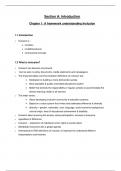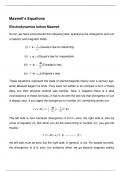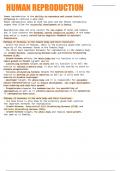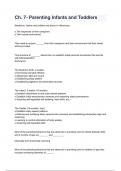Evolution
10 March 2022 09:40
Variation in Populations
• Genetic variation may be introduced by:
- Independent assortment of chromosomes in metaphase I
- Crossing over between homologous chromosomes in prophase I
- Random mating between organisms
- Random fusion of gametes
- Mutation
• Environmental factors will also influence the phenotype, but they will not be passed onto the offspring
• These differences can be measured as quantitative differences (eg, mass, height), or as qualitative differences (eg, ABO blood group)
• These two types of variation tend to be caused by different patterns of genetic inheritance
Continuous Variation:
• Tends to be polygenic, eg, many genes have a combined effect on a single phenotype
• This leads to a continuous range of phenotypes (phenotypes exhibit a 'normal distribution')
• These genes have the same, often additive, effect
• Therefore different alleles at a single locus have small effects on the phenotype
• Environmental factors can influence the phenotype
• Eg, height, birth mass, number of stomata on a leaf
Discontinuous Variation:
• Phenotypes within populations have distinct categories
• They tend to be controlled by a single or a small number of genes
• Different alleles at a single gene locus can have large effects on the phenotype
• Different genes can have quite different effects on the phenotype
• Environment has less/no influence on phenotype
• Eg, blood type, albinism, tall and dwarf pea plants
Environment and Phenotype
• The phenotype can be affected by the interaction between the genotype of an individual and the environment
• Eg, many genes for height are inherited, but these only give the potential to reach a certain height. A lack of protein when young may result in stunted
growth
• Plants will show a variety of phenotypes, depending on their growing conditions
• Eg, plants lacking in magnesium will be unable to make chlorophyll and therefore will have yellowish leaves
• In Himalayan rabbits, temperature controls the gene for pigment production
• At low temperatures the gene is expressed and therefore the pigment is made, causing blacking fur
• In crocodiles, high temperatures of 32°C-34°C result in males, low temperatures of 28°C-30°C yield females. At intermediate temperatures over a narrow
range, both males and females are produced in varying proportions
• In humans, UV light triggers the production of melanin, a pigment found in skin. This reduces the risk of skin cancer
T-Test
• The t-test is applied to sample sizes of more than five and fewer than 30 sets of normally distributed data
• It provides a way of measuring the overlap between two data sets
• A large value of 't' means there is little overlap, so a highly significant difference between the two data sets
• Eg, an ecologist was investigating a woodland habitat and comparing the widths of ivy leaves growing in the shade with those growing in full sunlight
• Leaf widths were measured, but because the distance of the leaf along the stem also had an effect on leaf size, only the fourth leaf on every branch was
measured
•
• The null hypothesis assumes any differences under investigation has arisen by chance, so the null hypothesis is that there is no difference in size between sun
and shade leaves
• The role of the statistical test is to determine whether or not to accept or reject the null hypothesis
• If we reject it, it means we are confident that the difference between the sizes of the two types of leaf is statistically significant
• Once a value of t has been calculated, and the t value in this case is 2.1, we determine the degrees of freedom for the two samples
• (12 + 12) - 2 = 22
• We look down the column of significance levels (p) at the 0.05 level until we reach the line corresponding to the correct degrees of freedom
• The critical value at this point is 2.08
• Since the calculated t value (2.1) exceeds the critical value at the 0.05 level of significance, it indicates that there is a less than 0.05 or 5% probability that the
difference between the two samples is due to chance
• Therefore we can reject the null hypothesis and conclude that the difference between the two samples is significant
Natural Selection
Observations:
• Organisms produce more offspring than needed to replace themselves
• Established populations tend to stay the same size
• Members of the same species tend to resemble their parents, but also show variation amongst themselves
Deductions:
• There is a struggle for existence in the competition for resources, many will die
• Those organisms best suited to their environment will survive and reproduce. Their offspring will tend to inherit their beneficial characteristics
Competition for Resources:
• Normally as a population increases, various environmental factors come into play to keep numbers limited
• These factors may be biotic, caused by other living organisms, such as predators, competition for food, pathogens
• The factors may also be abiotic, water supply or nutrient levels in the soil
• As population numbers increase, overcrowding may occur, increasing the passing on of diseases
• Predators may move into the area one they've realised there's food there
• Fights are more likely to break out
• Food will become short in supply
• Nesting/burrowing space will become limited
• The result will be that of all the organisms born in a population, many will die from lack of food, predation and disease, leaving only a small proportion of
young to grow to adulthood and pass on their alleles
• Population growth may slow
• The population may even decrease if the pressure of environmental factors is sufficiently great
• Only when the number of individuals has fallen considerably will the numbers be able to grow again
• Over a period of time, population numbers may therefore oscillate about a mean level
• Gause's Law, two species competing for the same resource cannot coexist if all other ecological factors are constant
Evolution by Means of Natural Selection:
• There is variation within every population
• With rabbits, it may be that coat colour plays a role
• Normal rabbits are agouti in colour
• A few will have an allele combination which makes them white
• This will make them stand out from the rest and they are more likely to be picked off by predators
• The chances of a white rabbit in the wild passing on its alleles therefore becomes rare
• The term 'fitness' is often used to describe how well organisms are adapted to their environment
• Fitness is the capacity of an organism to transmit its genotype to its offspring
• Being eaten by a predator is an example of selection pressure
• Selection pressure increases the chances of some alleles being passed on and decreases the chances of others
• The effect of selection pressures on the frequency of alleles in a population is called natural selection
• Natural selection tends to keep things the same, this is stabilising selection
• So agouti rabbits are the best adapted rabbits to survive predation, so the agouti allele remains the most common
• As long as nothing changes, this will remain the situation
• There is an optimum birth weight for human babies
• Those with heavier or lighter birth weights are at a disadvantage and so less likely to survive
• This means that the alleles for particularly heavy or light babies are eliminated from the population
• Hence the population is stabilised
Directional Selection:
• If a new environmental factor or a new allele appears, then allele frequencies may change
• This is directional selection
• In this case, the majority of existing forms may no longer be best suited to the environment
• An example of this is the development of antibiotic resistance in bacteria
• A resistant bacterium has no selective advantage under normal conditions
• However, if exposed to antibiotics, those which carry a gene for resistance will survive and there will be an abrupt change in the genome of the population
• Bacteria only have one chromosome, so any mutation has an immediate effect on phenotype
• Antibiotic resistance often occurs on plasmids
• Plasmids are frequently transferred from one bacterium to another, even between different species
• So it is possible for resistance to arise in one species of bacterium and then be passed on to another
• The more we use antibiotics, the greater the selection pressure we put on bacteria to evolve resistance to them
Disruptive Selection:
• This is where particular environmental conditions favour the extremes of a phenotypic range over the intermediate phenotype
• As a result, the gene pool may be split in two and it is entirely possible that new species may arise
• A good example is the colonisation of plants by mine waste tips
• These often contain high concentrations of metals such as copper and lead
• Most plants can't grow on these mine waste sites
• However, some grasses have colonised the area so it seems that they must have developed resistance to toxic metals and can flourish where others can't
• Grasses are wind pollinated so breeding between resistant and non-resistant plants occurs
• When the resulting seeds land on the ground and start to germinate, disruptive selection may occur
• Both the non-resistant seeds trying to germinate on the toxic soil and the resistant seeds trying to germinate on the uncontaminated soil fail to reproduce
• The result is increasing divergence of populations into two different varieties of grass plants
Balancing Selection:
• Directional and stabilising selection tends to reduce variation
• Balancing selection has the opposite effect
• It is a process which maintains multiple alleles in a gene pool
• It does this at frequencies well above that due to mutation
• A good example of this is the sickle cell trait:
- A faulty allele HbS of the gene coding for the production of beta-globin in haemoglobin can produce sickling of red blood cells
- People who are homozygous for this allele have sickle cell anaemia
- This is severe and often lethal in its effects
- The possession of two faulty alleles clearly puts people at a severe selective disadvantage
- They are less likely to survive and reproduce
- Yet the frequency of this allele is very high in some parts of the world
- In some parts of East Africa, nearly 50% of the babies born are carriers of the allele and 14% are homozygous
- The parts of the world where the sickle cell allele is most common are also the parts of the world where malaria is most prevalent
- Malaria is the major source of illness and death in many parts of the world
- It has been found that people who are heterozygous for the sickle cell allele HbA HbS are much less likely to suffer from a serious attack of malaria than
people who are homozygous HbA HbA
- In malaria areas, heterozygotes are at a selective advantage as they do not suffer from sickle cell anaemia
- So both alleles remain in the population if malaria is an important environmental factor
- In non-malaria areas, the HbS allele has almost been completely removed from the population
Genetic Drift
• The examples we've just looked at show the effect of non-random processes on the allele frequencies of a population
• However, allele frequencies may also change due to a random process known as genetic drift
• This change occurs by chance because only some of the organisms of each generation reproduce
• It is most obvious when a small number of individuals are separated from the main population
• They form only a small sample of the original population so are unlikely to have the same allele frequency as the population as a whole
• Further genetic drift in this small population will alter the allele frequency even more and evolution of this population may be in a different direction from
the main portion of the population
• This process, which occurs in recently isolated small populations is called the founder effect
Population Genetics
• This is the study of genes in populations
• A population is a group of individuals of a species living in a defined area and able to reproduce to generate fertile offspring
• A population of snails in a garden may live near a compost heap in a smallish area, whereas a population of thrushes may occupy the same garden part of the
time, some other gardens and the neighbouring fields
• So the area occupied by a population depends not only on environmental factors but also on the size and mobility of the organism
10 March 2022 09:40
Variation in Populations
• Genetic variation may be introduced by:
- Independent assortment of chromosomes in metaphase I
- Crossing over between homologous chromosomes in prophase I
- Random mating between organisms
- Random fusion of gametes
- Mutation
• Environmental factors will also influence the phenotype, but they will not be passed onto the offspring
• These differences can be measured as quantitative differences (eg, mass, height), or as qualitative differences (eg, ABO blood group)
• These two types of variation tend to be caused by different patterns of genetic inheritance
Continuous Variation:
• Tends to be polygenic, eg, many genes have a combined effect on a single phenotype
• This leads to a continuous range of phenotypes (phenotypes exhibit a 'normal distribution')
• These genes have the same, often additive, effect
• Therefore different alleles at a single locus have small effects on the phenotype
• Environmental factors can influence the phenotype
• Eg, height, birth mass, number of stomata on a leaf
Discontinuous Variation:
• Phenotypes within populations have distinct categories
• They tend to be controlled by a single or a small number of genes
• Different alleles at a single gene locus can have large effects on the phenotype
• Different genes can have quite different effects on the phenotype
• Environment has less/no influence on phenotype
• Eg, blood type, albinism, tall and dwarf pea plants
Environment and Phenotype
• The phenotype can be affected by the interaction between the genotype of an individual and the environment
• Eg, many genes for height are inherited, but these only give the potential to reach a certain height. A lack of protein when young may result in stunted
growth
• Plants will show a variety of phenotypes, depending on their growing conditions
• Eg, plants lacking in magnesium will be unable to make chlorophyll and therefore will have yellowish leaves
• In Himalayan rabbits, temperature controls the gene for pigment production
• At low temperatures the gene is expressed and therefore the pigment is made, causing blacking fur
• In crocodiles, high temperatures of 32°C-34°C result in males, low temperatures of 28°C-30°C yield females. At intermediate temperatures over a narrow
range, both males and females are produced in varying proportions
• In humans, UV light triggers the production of melanin, a pigment found in skin. This reduces the risk of skin cancer
T-Test
• The t-test is applied to sample sizes of more than five and fewer than 30 sets of normally distributed data
• It provides a way of measuring the overlap between two data sets
• A large value of 't' means there is little overlap, so a highly significant difference between the two data sets
• Eg, an ecologist was investigating a woodland habitat and comparing the widths of ivy leaves growing in the shade with those growing in full sunlight
• Leaf widths were measured, but because the distance of the leaf along the stem also had an effect on leaf size, only the fourth leaf on every branch was
measured
•
• The null hypothesis assumes any differences under investigation has arisen by chance, so the null hypothesis is that there is no difference in size between sun
and shade leaves
• The role of the statistical test is to determine whether or not to accept or reject the null hypothesis
• If we reject it, it means we are confident that the difference between the sizes of the two types of leaf is statistically significant
• Once a value of t has been calculated, and the t value in this case is 2.1, we determine the degrees of freedom for the two samples
• (12 + 12) - 2 = 22
• We look down the column of significance levels (p) at the 0.05 level until we reach the line corresponding to the correct degrees of freedom
• The critical value at this point is 2.08
• Since the calculated t value (2.1) exceeds the critical value at the 0.05 level of significance, it indicates that there is a less than 0.05 or 5% probability that the
difference between the two samples is due to chance
• Therefore we can reject the null hypothesis and conclude that the difference between the two samples is significant
Natural Selection
Observations:
• Organisms produce more offspring than needed to replace themselves
• Established populations tend to stay the same size
• Members of the same species tend to resemble their parents, but also show variation amongst themselves
Deductions:
• There is a struggle for existence in the competition for resources, many will die
• Those organisms best suited to their environment will survive and reproduce. Their offspring will tend to inherit their beneficial characteristics
Competition for Resources:
• Normally as a population increases, various environmental factors come into play to keep numbers limited
• These factors may be biotic, caused by other living organisms, such as predators, competition for food, pathogens
• The factors may also be abiotic, water supply or nutrient levels in the soil
• As population numbers increase, overcrowding may occur, increasing the passing on of diseases
• Predators may move into the area one they've realised there's food there
• Fights are more likely to break out
• Food will become short in supply
• Nesting/burrowing space will become limited
• The result will be that of all the organisms born in a population, many will die from lack of food, predation and disease, leaving only a small proportion of
young to grow to adulthood and pass on their alleles
• Population growth may slow
• The population may even decrease if the pressure of environmental factors is sufficiently great
• Only when the number of individuals has fallen considerably will the numbers be able to grow again
• Over a period of time, population numbers may therefore oscillate about a mean level
• Gause's Law, two species competing for the same resource cannot coexist if all other ecological factors are constant
Evolution by Means of Natural Selection:
• There is variation within every population
• With rabbits, it may be that coat colour plays a role
• Normal rabbits are agouti in colour
• A few will have an allele combination which makes them white
• This will make them stand out from the rest and they are more likely to be picked off by predators
• The chances of a white rabbit in the wild passing on its alleles therefore becomes rare
• The term 'fitness' is often used to describe how well organisms are adapted to their environment
• Fitness is the capacity of an organism to transmit its genotype to its offspring
• Being eaten by a predator is an example of selection pressure
• Selection pressure increases the chances of some alleles being passed on and decreases the chances of others
• The effect of selection pressures on the frequency of alleles in a population is called natural selection
• Natural selection tends to keep things the same, this is stabilising selection
• So agouti rabbits are the best adapted rabbits to survive predation, so the agouti allele remains the most common
• As long as nothing changes, this will remain the situation
• There is an optimum birth weight for human babies
• Those with heavier or lighter birth weights are at a disadvantage and so less likely to survive
• This means that the alleles for particularly heavy or light babies are eliminated from the population
• Hence the population is stabilised
Directional Selection:
• If a new environmental factor or a new allele appears, then allele frequencies may change
• This is directional selection
• In this case, the majority of existing forms may no longer be best suited to the environment
• An example of this is the development of antibiotic resistance in bacteria
• A resistant bacterium has no selective advantage under normal conditions
• However, if exposed to antibiotics, those which carry a gene for resistance will survive and there will be an abrupt change in the genome of the population
• Bacteria only have one chromosome, so any mutation has an immediate effect on phenotype
• Antibiotic resistance often occurs on plasmids
• Plasmids are frequently transferred from one bacterium to another, even between different species
• So it is possible for resistance to arise in one species of bacterium and then be passed on to another
• The more we use antibiotics, the greater the selection pressure we put on bacteria to evolve resistance to them
Disruptive Selection:
• This is where particular environmental conditions favour the extremes of a phenotypic range over the intermediate phenotype
• As a result, the gene pool may be split in two and it is entirely possible that new species may arise
• A good example is the colonisation of plants by mine waste tips
• These often contain high concentrations of metals such as copper and lead
• Most plants can't grow on these mine waste sites
• However, some grasses have colonised the area so it seems that they must have developed resistance to toxic metals and can flourish where others can't
• Grasses are wind pollinated so breeding between resistant and non-resistant plants occurs
• When the resulting seeds land on the ground and start to germinate, disruptive selection may occur
• Both the non-resistant seeds trying to germinate on the toxic soil and the resistant seeds trying to germinate on the uncontaminated soil fail to reproduce
• The result is increasing divergence of populations into two different varieties of grass plants
Balancing Selection:
• Directional and stabilising selection tends to reduce variation
• Balancing selection has the opposite effect
• It is a process which maintains multiple alleles in a gene pool
• It does this at frequencies well above that due to mutation
• A good example of this is the sickle cell trait:
- A faulty allele HbS of the gene coding for the production of beta-globin in haemoglobin can produce sickling of red blood cells
- People who are homozygous for this allele have sickle cell anaemia
- This is severe and often lethal in its effects
- The possession of two faulty alleles clearly puts people at a severe selective disadvantage
- They are less likely to survive and reproduce
- Yet the frequency of this allele is very high in some parts of the world
- In some parts of East Africa, nearly 50% of the babies born are carriers of the allele and 14% are homozygous
- The parts of the world where the sickle cell allele is most common are also the parts of the world where malaria is most prevalent
- Malaria is the major source of illness and death in many parts of the world
- It has been found that people who are heterozygous for the sickle cell allele HbA HbS are much less likely to suffer from a serious attack of malaria than
people who are homozygous HbA HbA
- In malaria areas, heterozygotes are at a selective advantage as they do not suffer from sickle cell anaemia
- So both alleles remain in the population if malaria is an important environmental factor
- In non-malaria areas, the HbS allele has almost been completely removed from the population
Genetic Drift
• The examples we've just looked at show the effect of non-random processes on the allele frequencies of a population
• However, allele frequencies may also change due to a random process known as genetic drift
• This change occurs by chance because only some of the organisms of each generation reproduce
• It is most obvious when a small number of individuals are separated from the main population
• They form only a small sample of the original population so are unlikely to have the same allele frequency as the population as a whole
• Further genetic drift in this small population will alter the allele frequency even more and evolution of this population may be in a different direction from
the main portion of the population
• This process, which occurs in recently isolated small populations is called the founder effect
Population Genetics
• This is the study of genes in populations
• A population is a group of individuals of a species living in a defined area and able to reproduce to generate fertile offspring
• A population of snails in a garden may live near a compost heap in a smallish area, whereas a population of thrushes may occupy the same garden part of the
time, some other gardens and the neighbouring fields
• So the area occupied by a population depends not only on environmental factors but also on the size and mobility of the organism









